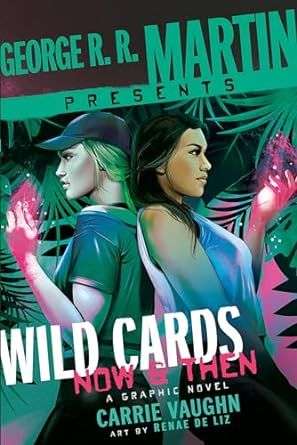We’ve implemented some new protocols around sending us messages via this website. Please email website “at” britishfantasysociety “dot” org for any issues.

For all things fantasy, horror, and speculative fiction
-
Announcement:

Wild Cards: Now & Then
George R.R. Martin Presents WILD CARDS: NOW & THEN
A graphic novel by Carrie Vaughn: Art by Renae De Liz
Bantam, HC, £19.47

Reviewed by Pauline Morgan
The Wild Card universe has been around since 1987 with many stories, anthologies and media adaptations between then and now. The premise is an alternative history stream beginning in 1946 when an alien virus ravaged the world. Ninety per cent of those who contracted it died. Of the rest, their DNA was altered. Of the survivors, the Aces developed superpowers, but the Jokers were bizarrely mutated. There have been a number of volumes of short stories, novels and iterations in other media. The project has involved more than forty authors.
Now & Then is a graphic novel and, as such, involves more than just the writer of the script provided by Carrie Vaughn. This story involves two Aces who have worked in tandem on previous occasions. Ana Cortez is an Earth Witch who can move the earth, or as she expresses it, move the constituent pieces it is made of. Kate Brandt’s Ace name is Curveball, and she is capable of blowing things up by throwing small items, like stones. Both Aces are called in to meet the prosecuting attorney for the Ministry of Justice in Brazil. Diana Rocha wants Ana and Kate to go over the events of a mission to Brazil a year ago.
At that time, the two women were sent as observers to investigate a complaint about activities at a missionary settlement. They began to suspect something was not right when they were waylaid by Jorge Ribeiro, who had laid on distractive sightseeing tours on behalf of the mayor’s office. Making a break for it, they eventually met with Gabriel Silva, who had made the original complaint. Avoiding Ribeiro, he takes Ana and Kate upriver to see the Aurora Mission, run by Joseph Marten. Outwardly, the place, advertised as an educational refuge for Joker children, looks delightful – too ideal to be true. The Aces decide they want a closer look, even if it means overstepping the details of their brief. Breaking in, using Ana’s skills, they soon find themselves in the midst of chaos.
The story is told as an alternation of Now, the investigation by Diana Rocha, and Then, the recapping of the events that triggered her investigation. Like the Aurora Mission, what appears to be true on the surface is not the total truth. It is worth reading the text more than once to catch all the nuances Vaughn has put into the story.
As with any graphic novel, the artwork is as important as the text in telling the story. The images of Renae de Liz are clear and crisp. Like the best graphic artists, she puts the important features in the foreground of a panel but doesn’t neglect the background. Where a writer would spend a paragraph on description, De Liz unobtrusively puts it all in the panel. It is worth looking at the more complex panels to see their wealth of detail. She is also very good at putting relevant expressions on her characters, not just facial ones, but in positioning their bodies, giving them movement. This skill means that not all panels have to contain words as the illustrations speak as loudly without the need for them.
This is a case where the author and artist working together create something greater than the sum of the individual parts. The book deserves to be perused a number of times, and the pleasure of doing so doesn’t diminish. An excellent production.
Explore the blog:
Blog categories:
Latest Posts:
Tags:
#featured (56) #science fiction (25) Book Review (264) events (44) Fantasy (231) Graphic Novel (13) horror (136) Members (62) Orbit Books (48) profile (43) Romance (17) Science Fiction (50) short stories (28) Titan Books (52) TV Review (15)
All reviews
Latest Reviews:
- THE HOUSE ON THE BORDERLAND by William Hope Hodgson
- Monstrum by Lottie Mills
- Mood Swings by Dave Jeffery
- Yoke of Stars by R.B. Lemberg
- Hera by Jennifer Saint
- The Black Bird Oracle by Deborah Harkness
- RETURN OF THE DWARVES By Markus Heitz
- Delicious in Dungeon
- Toxxic by Jane Hennigan
- THIS ISLAND EARTH: 8 FEATURES FROM THE DRIVE-IN By Dale Bailey
Review tags:
#featured (2) Action (4) Adventure (4) Book Review (28) Fantasy (18) Featured (2) Feminist (2) Gothic Horror (3) Horror (14) Magic (3) Orbit Books (3) Romance (6) Science Fiction (5) Swords and Sorcery (2) Titan Books (7)